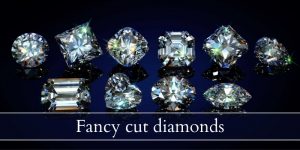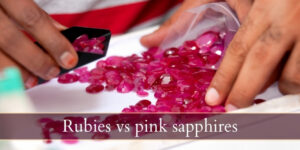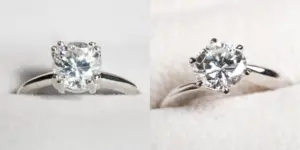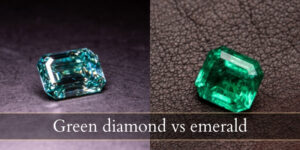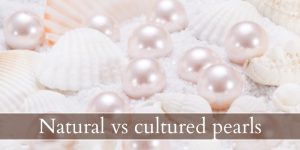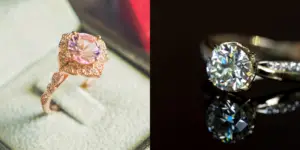Ruby engagement rings have a certain vintage air to them, as do most colored gemstone rings. You imagine grand counts and duchesses wearing these gems and you wonder how you’d look with one of your own. Or how your loved one would look with a ruby engagement ring. Well wonder no more, because today we’re going to walk you through a ruby engagement ring’s meaning, general price range, and what to look out for when buying one.
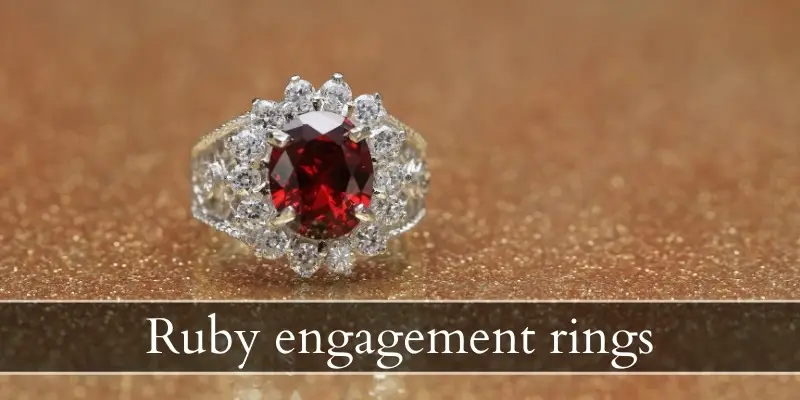
Ruby engagement ring meaning
A ruby engagement ring signifies passion, vigor, courage, energy, and is often associated with nobility due to its intense red hue. Rubies have long been viewed as symbols of passion and romantic love, bringing good fortune to those who wear it. Rubies may also attract misfortune at times, as it’s a very noticeable gemstone and color.
Rubies are part of the ancient cardinal gems, along with emeralds, sapphires, diamonds, and formerly amethysts. These were gems that only the nobility could wear, and many fought over.
A ruby engagement ring will stand out from the crowd and the wearer is bound to be complimented for the intense gemstone. Not everyone can wear a red ruby engagement ring confidently, but those who do manage to impress with their boldness and passion for life.
Some of the most famous ruby engagement rings belong to:
- singer Katy Perry
- Sarah Ferguson, Duchess of York
- singer Jessica Simpson, and it’s also her birthstone
- actress Eva Longoria
- model and singer Victoria Beckham
Is ruby good for an engagement ring ?
Yes, ruby is a great gemstone for an engagement ring as it attracts love, passion, and vigor into the relationship. And rubies are fairly tough stones, ranking a 9 on the Mohs scale of hardness. This means they can be prong set and still resist scratches or chipping.
We recommend pairing a beautiful red ruby with yellow gold, to bring out the warmth of the gemstone. A white gold or platinum may also work, though the overall effect will be a pinkish hue or a colder appearance.
Read also: Engagement Ring VS Wedding Ring
How much is a 2 carat ruby ?
A 2 carat ruby is pretty expensive if you want to buy one that is eye clean and has a satisfactory color. For example a 2.03 cts eye clean medium red ruby with an emerald cut goes for as much as $48k.
A better colored ruby, also 2.03 cts eye clean gem that has pigeon blood coloring and a cushion cut goes for $42k. You can find rubies at a much lower price but their quality suffers greatly. You may find a poor color, a cloudy gem, or one that has been heat-treated and filled.
Why is ruby so expensive ?
Ruby is so expensive because it’s actually rarer than a diamond. While all gemstones are pretty rare, some occur more often than others in the earth’s crust. Rubies are the same type of material as sapphire, but they owe their red coloration to trace amounts of chromium instead of aluminum and titan.
Compared to sapphires, rubies are much more rare and twice the asking price. Compared to diamonds, rubies are rarer and run for a similar price. You have to remember that diamond prices are a bit artificial.
The only thing that could beat a ruby in price is perhaps a red diamond. Those are some of the rarest diamonds, perhaps the rarest coloration ever. Such a diamond with the perfect color and clarity could put a ruby to shame.
Can you mix rubies and diamonds on a ring ?
Yes, you can mix rubies and diamonds on a ring and they will actually enhance each other’s colors. The deep, striking red of a ruby will make most diamond color grades appear white, so you can probably get away with a set of G-I diamonds, though we recommend not going lower than that. Set everything in an 18k yellow gold band and you’re good to go !
What to know when buying a ruby engagement ring
So you’ve set your heart on a ruby ring. Beautiful ! We recommend going around town and looking at various ruby rings so you get a better idea of what it would look like in real life. Buying rings online is fine, but nothing ever beats the real thing. At least it never did when we bought our rings, we had a blast looking for the prefect one.
So, back to ruby engagement rings, you’re going to drop a good amount of money on that ring. You need to make sure you get a good deal and find the perfect ruby for you. Here’s what to watch out for.
Gemstone treatment
Many, many gemstones on the market are improved in one way or another. It could be heat treatment for better color, glass filling to fill in any fractures, another treatment to remove impurities and improve clarity, maybe oiling, etc.
The point is, whatever ruby you’re buying, it should have a certificate stating its color and whether it was enhanced in some way or not. There’s nothing wrong with enhanced rubies, but they do come much cheaper that 100% natural ones that get the perfect color and clarity.
The most common ruby treatment is heat treating and glass filling. Heat treating improved (deepens) color, and also dissolves some of the whitish impurities in a ruby. This gives it better clarity and color.
Glass filling is literal filling of the tiny cracks that may be present in a ruby with transparent glass. The amount of glass is tiny, but it’s there and should only improve clarity, not get in its way.
Look for color and clarity
When buying your ruby carats do matter, but color and clarity matter even more than they do in a diamond. After all, you’re buying a ruby mostly for its color. And not all rubies have that beautiful bright red hue. Some are lighter, more like pink, some have a purplish hue, and some are simply too dark and won’t show much color play even with the best cut possible.
So check that you really, really like that color and the clarity. Many rubies are not perfectly clear, meaning the ones that are labeled as eye-clean are the best you can get. Because of this, a step-cut may not be the best idea for a ruby as it will showcase any and al imperfections.
Check that you’re not getting a garnet or spinel instead
When buying a ruby your risk getting duped with another, cheaper gemstone. To be fair this can happen with any gemstone, not just rubies. So what are the most common ruby dupes ? Garnet and spinel. Both are great gems in their own way, but they’re much cheaper and you don’t want to be paying extra for something you didn’t ask for.
Ask for the gemstone’s certificate, that’s always the easiest and safest method. Otherwise you might not know what you’re buying, especially if you’ve never bought rubies or gems in general.
So how do you tell a ruby from a garnet or spinel ? There’s a hardness test, with rubies ranking a 9.0 on the Mohs scale, garnet a 7-7.5 (as pyrope) and spinel 8.
There is also a color test, but you need all three stones to compare. A ruby ranges from pinkish to deep red, without bordering into golden-brown. If anything it has purplish hues.
A garnet has a deep red color but with yellow-brown undertones and is often a darker shade than the most saturated ruby.
Spinels may be true red, orangish red, or purplish red. This is difficult to tell from a ruby, and it’s why in ancient times red spinels were considered rubies.
Make sure you get the real deal, whether it’s synthetic (lab-created), natural, filled, treated, or any possible combination.

I’m the main author for jewelrymaterialguide.com. I started this site after we did tons of research before our wedding and noticed that there is information about rings, jewelry, and so on that is really hard to find on the internet.

